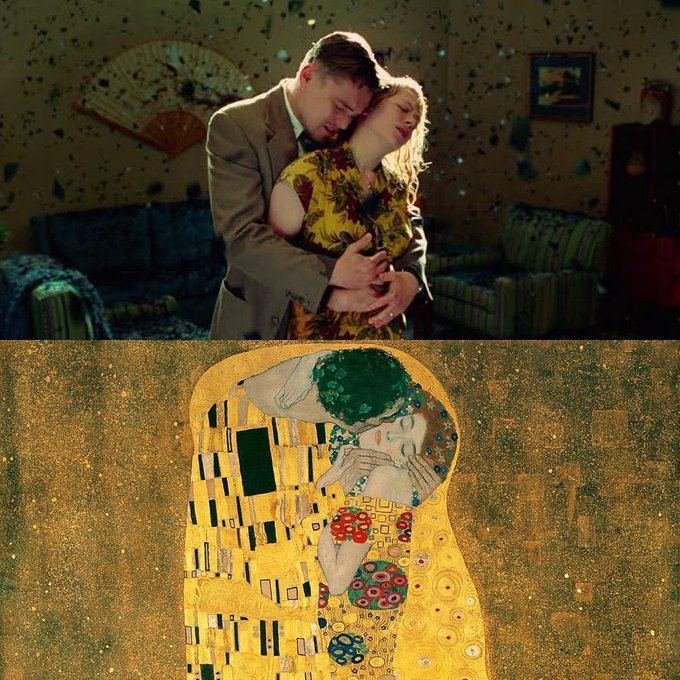Art on Screen: 10 Masterworks of Painting that Inspired Iconic Movie Scenes
Have you ever watched a movie and felt a strange sense of familiarity, as if you've seen it somewhere before? This déjà vu might stem from the canvas, not the screen. Films often draw inspiration from the world of painting, with directors using iconic artworks to enhance the visual storytelling of their movies. Today, we delve into ten masterpieces that have not just influenced, but directly shaped, some of cinema's most unforgettable scenes.
1. The Kiss & Shutter Island
Martin Scorsese's 'Shutter Island' harbors a secret - its inspiration from Gustav Klimt's 'The Kiss'. The film's portrayal of love and madness finds a parallel in Klimt's golden, intimate embrace, bringing an added depth to the movie's complex narrative.
2. Nighthawks & Pennies from Heaven
The sense of urban isolation in Edward Hopper's 'Nighthawks' infiltrates 'Pennies from Heaven' by Herbert Ross. The film's lonely diner scene directly mirrors Hopper’s painting, creating a cinematic moment where life imitates art in its loneliest form.
3. Prisoners' Round & A Clockwork Orange
Stanley Kubrick's 'A Clockwork Orange' owes its swirling chaos to Vincent van Gogh's 'Prisoners' Round'. The painting's tumultuous brushstrokes echo through the movie, creating a visual representation of the film’s own whirlwind of disorder.
4. The Birth of Venus & The Adventures of Baron Munchausen
Terry Gilliam's 'The Adventures of Baron Munchausen' takes a leaf out of Sandro Botticelli's 'The Birth of Venus'. The movie's dreamy landscapes are a cinematic tribute to Botticelli’s depiction of beauty and mythology.
5. Morning Sun & Shirley: Visions of Reality
In 'Shirley: Visions of Reality', director Gustav Deutsch channels Edward Hopper's 'Morning Sun'. The film's scenes, bathed in Hopperesque light, blur the lines between reality and imagination, paying homage to Hopper's unique perspective.
6. The Tower of Babel & Metropolis
Fritz Lang's 'Metropolis' finds its architectural muse in Pieter Bruegel the Elder's 'The Tower of Babel'. The movie’s towering cityscapes reflect Bruegel’s depiction of ambition and chaos, offering a futuristic take on this classical theme.
7. The Elephants & Mad Max: Fury Road
Salvador Dalí's 'The Elephants' strides into George Miller's 'Mad Max: Fury Road'. The movie's desolate landscapes and peculiar machinery are a nod to Dalí’s surreal landscapes, showcasing the influence of surrealism in modern cinema.
8. Wheatfield with Crows & Dreams
Akira Kurosawa's 'Dreams' brings Vincent van Gogh’s 'Wheatfield with Crows' to life. The film captures the emotional turbulence of Van Gogh's painting, creating a visual homage that resonates with the artist’s troubled genius.
9. The Empire of Lights & The Exorcist
William Friedkin's 'The Exorcist' mirrors the paradoxical nature of René Magritte's 'The Empire of Lights'. The film’s play on light and darkness reflects Magritte’s exploration of reality and illusion, adding a surreal depth to the cinematic narrative.
10. The Scream & Scream
Finally, Wes Craven's 'Scream' finds its iconic mask in Edvard Munch's 'The Scream'. The movie’s memorable mask is a direct descendant of Munch's agonized figure, turning a painting into a pop culture phenomenon.
Conclusion
These films showcase the profound impact that art can have on cinema. By borrowing elements from these masterworks, filmmakers not only pay homage to the artists but also enrich their own visual storytelling. As we see, the line between the canvas and the camera is often beautifully blurred, creating a rich tapestry of artistic expression that transcends mediums.










